Erasing “wire blight” in Topanga
March 8, 2011
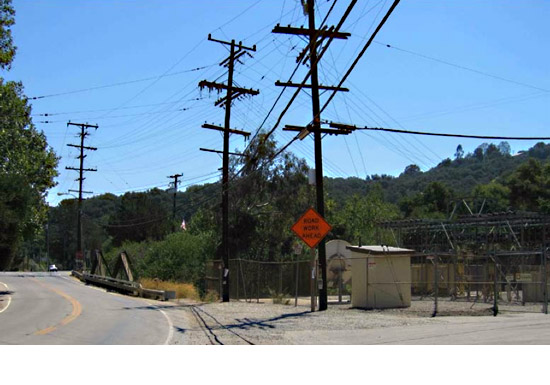
It isn’t the sexiest construction project in Los Angeles County. And it won’t be finished until 2014.
But to anyone acquainted with the hazards of fire season—or just the hazards of trying to find an unobstructed view in pretty-but-populous Southern California—the plans taking shape this month in Topanga eventually should offer a whole new perspective.
Next week, the county Department of Public Works and Southern California Edison representatives will launch a series of meetings to discuss the undergrounding of overhead utility lines in the rural community’s central business district around Topanga Canyon Boulevard and Old Topanga Canyon Road.
The $2.4 million project, which will be paid for by a statewide utility fee administered by Southern California Edison in L.A. County, will bury about a third of a mile’s worth of electricity, cable and phone lines that now clutter the view and present ongoing traffic and fire hazards along the right-of-way.
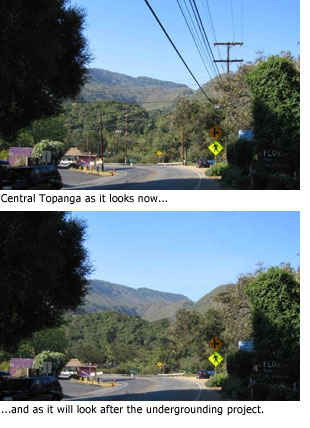 “The main goal is aesthetic, but there’s also a safety issue,” says Steve Dunn, a senior civil engineer at Public Works. Power poles along winding roads, such as Topanga’s, raise the risk of motor vehicle crashes. And in recent years, at least three massive Southern California brushfires have erupted as tree limbs and lashing utility lines have been blown into overhead power conductors by Santa Ana winds elsewhere in the region.
“The main goal is aesthetic, but there’s also a safety issue,” says Steve Dunn, a senior civil engineer at Public Works. Power poles along winding roads, such as Topanga’s, raise the risk of motor vehicle crashes. And in recent years, at least three massive Southern California brushfires have erupted as tree limbs and lashing utility lines have been blown into overhead power conductors by Santa Ana winds elsewhere in the region.
The project is one of many funded by the California Public Utility Commission’s so-called “Rule 20” program, which combats “wire blight” by helping communities and municipalities bury utility lines. Rule 20 regulates a utility’s recovery of the costs of undergrounding overhead electric equipment and gives local governments dibs on a share of a power company’s capital budget according to the number of rate-payers in each jurisdiction.
The annual amounts are not large—the average cost of an undergrounding project only adds about a nickel a month to the average residential customer’s electric bill, according to SCE—but over time, a municipality’s share can accumulate.
Unincorporated Los Angeles County’s allotment, for instance, amounts to about $3 million annually, which the County then splits among its five supervisorial districts.
The Topanga project will be funded by nearly two decades’ worth of the Third Supervisorial District’s allotment.
Other recent projects include a $4 million undergrounding project in an unincorporated area near Arcadia and a $10 million undergrounding and reconstruction project along 2.6 miles of Rosemead Boulevard.
This month’s meeting, Dunn says, will acquaint the community with the project and launch the environmental documentation. (And notify Topangans, incidentally, that construction is expected to take about 1½ years once it breaks ground in 2013.) The gathering is scheduled for 7 p.m. at the Topanga Elementary Charter School Auditorium.
Posted 3/8/11
This is how the county rolls
March 6, 2011
 Back in September, the Department of Public Social Services began fighting hunger where it lives by using a mobile unit to help people sign up for food assistance. During the the next few weeks, it’ll be headed into Hollywood and the San Fernando Valley.
Back in September, the Department of Public Social Services began fighting hunger where it lives by using a mobile unit to help people sign up for food assistance. During the the next few weeks, it’ll be headed into Hollywood and the San Fernando Valley.
The Health and Nutrition Mobile Services Unit essentially is a traveling DPSS office, complete with computers and staffers to help with paperwork. Its mission is a crucial one, especially in these challenging economic times.
Only about half of eligible county households currently are enrolled in the CalFresh program, formerly known as food stamps. This means government funds are going untapped and families are going without help to meet their basic nutritional requirements.
The Mobile Services Unit has begun to make a dent in the disparity. It has distributed more than 700 applications, with 430 of them being returned as of last week.
Although its primary work is to bring CalFresh to those who need it, the unit also will offer other services, including help with Medicaid applications. Various community groups are providing the venues for the DPSS truck and supplying their own services.
This month, the Health and Nutrition Mobile Services Unit will be in the Third District at three locations. They are:
Friday, April, 8, from 9 a.m. to 2 p.m.
Los Angeles City College – Mini Resource Event
4311 Melrose Ave., Los Angeles, 90029
Wednesday, April 20 from 9 a.m. to 2 p.m.
Van Nuys Worksource Center – La Mission College
11623 Glenoaks Blvd., Pacoima, 91331
Saturday, April 30 from 9 a.m. to 1 p.m.
Canoga Park Farmers Market & Community Health Fair – at the Community Center
7428 Owensmouth Ave., Canoga Park, 91303
Posted 4/6/11
Art opening at the Schindler House
March 3, 2011
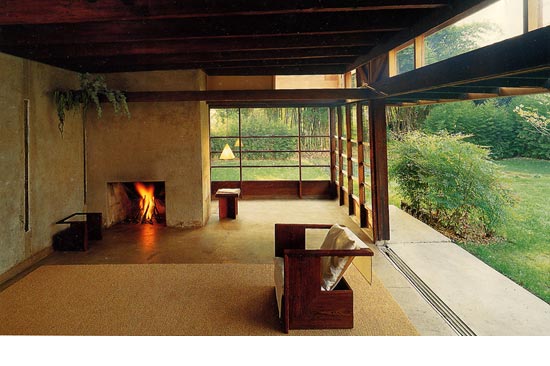
Art and early 20th century modern architecture harmonize in the MAK Center’s Schindler Lab, Round One. This installation exhibit features three-dimensional works by artist Olivia Booth and architect Thurman Grant, who unite to highlight the world-famous Schindler House, an archetypal Modernist dwelling designed by R.M. Schindler.
Sara Daleiden and Kimberli Myer of the MAK Center developed the project and helped the artists install the works while protecting the 1922 structure. Artists Booth and Grant spent regular time cultivating genuine love for the house before using their skills to build exhibits that complement and interpret the original vision of Schindler. Colored glass and mirrored structures are used to double the appearance of the space and draw attention to the physical “rhythm” of the house. Booth described the endeavor:
“My own experience of the Schindler house at King’s Road, after years of visiting it, has been of self reflection; so part of my installation comes down to how a house itself self-reflects, and in turn acts as a reflecting chamber for those who move through it.”
Schindler Lab, Round One opens Saturday, March 5, with a free reception from 3 to 5 p.m. Dancer/choreographer Nancy Sandercock will interact with the art in a special performance. The installation, the first in a series that pairs artists with the house, will remain open to the public during normal museum hours until April 24. Normal admission is $7 per day for adults, $6 per day for students and seniors, and free for children under the age of 12.
The Schindler House is located at 835 N. Kings Road in West Hollywood. Plan your trip with Metro, or drive there yourself. Parking is available at the public structure at the northeast corner of Kings Road and Santa Monica Boulevard.
Posted 3/3/11
Battle of the baristas in Hollywood
March 3, 2011

Coffee connoisseurs can watch the most skilled baristas in the Southwest compete this weekend for a chance to go to the 2011 U.S. Barista Championship.
The Southwest Regional Barista Competition hosts 40 competitors from seven states, who will pull their best espressos Friday and Saturday for a chance to be one of six finalists Sunday who are invited to compete nationally. Each barista has 15 minutes to prepare and serve three coffee courses to a panel of judges. They will be scored based on procedure, consistency, cleanliness, technical expertise, and, of course, taste.
All of the slots to participate this year have been filled, but 1,600 spectators (twice as many as last year) are expected to attend the event, which is sponsored by The Coffee Bean & Tea Leaf. Free coffee will be available to all at the brew bar, and gourmet food trucks including Buttermilk Truck, Manila Machine, Hungry Nomad and Sweets Truck will be on hand to sell their creations. A food truck schedule is available on the website so you can be first in line when your favorite arrives.
The competition will run from 11 a.m. to 5 p.m. on Friday and Saturday. The final round opens at 10:30 a.m. on Sunday, and awards will be given from 1:30 to 2 p.m. Check the full schedule of events for details. The event will be held indoors at Siren Studios, 6063 W. Sunset Ave., Hollywood. Parking will be available in an adjacent lot, but is limited. The event is just a short walk from the Hollywood/Vine station of Metro’s Red Line, so you may want to plan to arrive by subway.
Free after parties with live music will be announced at the competition if you want to continue the celebration after the grinding has stopped. The after parties benefit MusiCares, which provides assistance and resources to musicians in times of need or crisis.
If you want to see what to expect from a top-flight barista, watch this video of World Barista Champion Tim Varney describing the craft.
Posted 3/3/11
A sharp U-turn on Mulholland
March 3, 2011
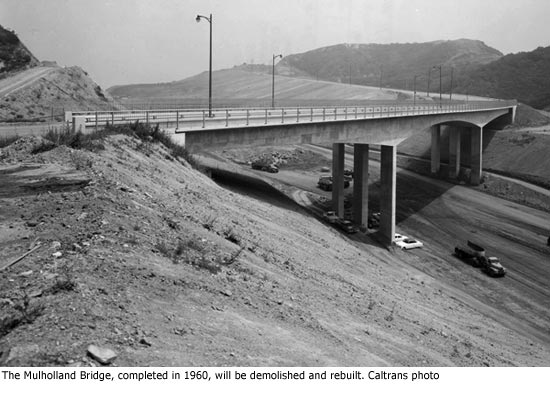
In the end, it was a bridge too far.
A short-lived plan to build a new Mulholland Bridge before tearing down the existing one as part of the I-405 Sepulveda Pass project has been scrapped, less than six months after it was announced to cheers from many in the project’s Community Advisory Committee. Project officials instead are reverting to their original plan of demolishing and rebuilding the existing bridge in two stages—although that’s expected to be costlier and more disruptive to traffic.
It’s also expected to take longer. Mike Barbour, who’s heading up the project for Metro, says that even though the freeway project as a whole remains on track to largely finish by May or June, 2013, the about-face will likely delay the Mulholland Bridge’s reopening for up to three months.
The change of plans comes after a Los Angeles city design review board weighed in on the project, asking for modifications and pushing Metro to go back to the drawing board to create an “extraordinary,” visually striking redesign of the bridge.
At the same time, the Brentwood Residents Coalition filed a series of objections to the project, arguing that the new-bridge plan would hurt the Mulholland corridor’s scenic quality and violate the California Environmental Quality Act if it went forward without a comprehensive environmental review. Letters expressing concern also came from the Bel Air Skycrest Property Owners Association and the Santa Monica Mountains Conservancy.
Their concerns included fears that the new configuration would interfere with the wildlife corridor around the bridge and break up Mulholland Drive by creating a “T-intersection” at the bridge, chopping the road into two segments.
The creation of an all-new Mulholland Bridge would break “the sinuous, continuous line of the beautiful and historic mother road,” Lois Becker, president of the Bel Air Skycrest group, wrote in a letter to the city’s Mulholland Scenic Parkway Specific Plan Design Review Board.
Toni Lewis, an architect on the design review board, said members had not set out to block the new-bridge plan and had made reasonable recommendations to Metro that could have been worked through.
The look of the proposed new bridge, developed in consultation with the project’s Community Advisory Committee, had been intended to mimic the existing structure, completed in 1960. But Lewis said too little consideration had been given to designing something better to befit one of the city’s landmark roadways.
“This is something that’s important and we’re treating it like the overpass at Overland, which it’s not,” she said. “I just thought that it was a total missed opportunity to leave something [the city] could be proud of.”
Metro said the design panel’s recommendations, along with concerns that it might be sued by the residents’ coalition, prompted it to reverse course rather than confront potential delays in court and in the design process.
“Unfortunately, we don’t have the luxury of time,” Yvette Rapose, Metro’s community relations manager for the project, said in a Feb. 25 letter to interested parties. Her letter said the agency was doing so even though it was confident that it had been on “firm legal ground” and would have prevailed in a court fight.
The $1.034 billion project is a Metro-Caltrans collaboration to add a 10-mile northbound carpool lane to the 405, along with other improvements. As part of the design-build process, Metro has been regularly meeting with the project’s Community Advisory Committee, made up of representatives from residents’ groups in the surrounding areas.
The idea of minimizing disruption by building a new Mulholland Bridge before knocking down the old one grew out of a meeting with community members last summer, and was supported by many on the advisory committee, particularly those from Encino and Sherman Oaks.
“I think it’s unfortunate that the best solution didn’t come out of the process,” said Barbour, who’d previously estimated that the new-bridge approach on Mulholland could have saved from $4 million to $10 million. He said the majority of the project’s advisory committee members had favored the construction of a new bridge. “A lot of people were supportive. They just weren’t as vocal as the people who were non-supportive.”
“The long and the short of it is: here we are back at square one,” said Laurie Kelson, a member of the Community Advisory Committee, as well as vice president of the Encino Neighborhood Council and chair of its traffic and transportation committee. Kelson had supported the idea of building a new bridge before tearing down the old as a better way to ensure good emergency response times in the heavily-traveled area and to lessen the overall traffic impact of construction.
She said the process should have given more weight to the opinions of those who live closest to the affected area. “There’s something wrong with the process,” she said. Community representatives from “each segment of this project should really be making the more important decisions about their segment.”
Since the challenge to the new-bridge plan also came from within the Community Advisory Committee, there have been some tensions within the group. But nobody seems to feel that any bridges have been permanently burned. “Did I wish they never started this? Absolutely,” Kelson said, of the committee’s dissenters to the plan. “But certainly there are a lot of good people to work with.”
Wendy-Sue Rosen, a member of the Community Advisory Committee and also president of the Brentwood Residents Coalition, which challenged the new-bridge plan, predicted that the advisory committee would be able to put the differences of opinion behind them.
“We are all strong advocates and disagreement is part of the process. But we pull together when necessary for a common goal,” Rosen said in an e-mail. “I don’t think that the differences of opinion over the Mulholland Bridge will make it harder to work collaboratively with each other or with Metro to ensure the project moves forward in the least disruptive manner.”
Posted 3/3/11
Toot your own horn at Public Practice
March 3, 2011
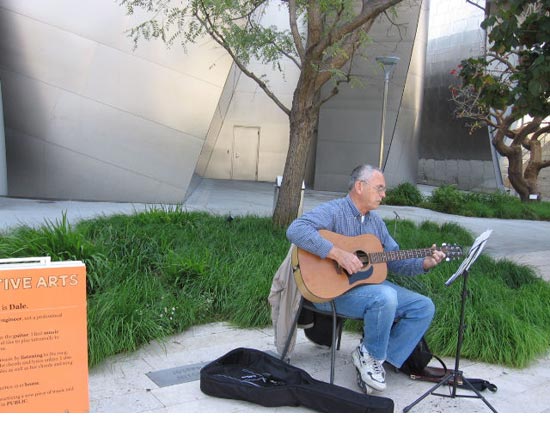
To paraphrase the old joke: How do you get to the Music Center? Practice!
This spring, that will be literally true because of a program called Public Practice, which provides amateur musicians with an opportunity to practice their instruments in outdoor public areas on the Music Center campus.
Register solo or as a duo by March 15 for two 30-minute daytime sessions on Wednesdays and Fridays in April. Musicians must be at least 18 years old to participate. Bring your own music and stands, but leave the electric guitar at home—this program is limited to acoustic instruments only.
If you are concerned about your skill level, take a deep breath and dive in anyway. You are free to goof, improvise, bumble or noodle, and it doesn’t even matter if the instrument is totally new to you. No matter how skilled (or unskilled) you are, you will be contributing to a soundscape comprised of all the musicians practicing simultaneously in the program. Visitors can walk along the paths of the Music Center and experience the atmosphere you create.
Public Practice is in its 3rd year. Past participants have enjoyed the opportunity to “take it up a notch” from their living rooms, bedrooms, and studios by playing out in the public. Many of those who practice form lasting friendships, and once the program has ended, all are invited to join in a dinner and discussion to share their experiences. Bring your marimbas, trumpets, violas, harps and didjibodhráns. We’ll keep an ear out for you.
Posted 3/3/11
Budging on the budget
March 2, 2011
We spoke—and the governor listened.
This week, Gov. Brown’s office announced that he’d scaled back one of the most onerous facets of his “realignment” plan to erase the state’s $26 billion deficit. Responding to concerns and criticisms of county leaders and law enforcement officials across the state, Brown significantly shrank the numbers of state prisoners and parolees he’d planned on putting under the management of California’s counties.
And that’s good news for a couple reasons.
First, our local criminal system already is bursting at the seams. Our jails are overcrowded and we simply don’t have the kind of staffing—or the money—needed to supervise the huge numbers of parolees with which the governor wanted to saddle us. The Board of Supervisors, Sheriff Lee Baca and District Atty. Steve Cooley had made this abundantly clear to Sacramento.
And second, Brown’s concession shows he’s willing to compromise in the face of compelling evidence—a refreshing development in an age of political brinksmanship. His change of course suggests that his overtures to us are sincerely intended to ensure that his budget plan doesn’t just undermine another branch of government—in our case, L.A. County.
Still, this is just a beginning. The governor’s budget remains a work in progress. And with the clock ticking, there are a number of other areas that must be addressed immediately.
Of particular concern is the question of how Brown’s realigned services would be funded down the road. Under his current plan, he’s banking on the public to pick up the tab for five years by voting to approve $5.9 billion in tax extensions. But what happens after that, assuming voters even get on board?
Currently, there are no airtight guarantees that the state’s counties would get the necessary funding for such realigned programs as foster care, substance abuse, mental health, adult parole and the incarceration of inmates formerly held in state prisons. Along these same lines, there also are no protections for counties should they face rising costs for new or unanticipated federal program requirements.
My colleagues and I believe that only a constitutionally-guaranteed stream of revenue can ensure that these programs do not break the county’s bank in five years when the voter-approved tax extensions would be set to expire. Although the Brown Administration has drafted language for a constitutional amendment, it remains thin on details, failing to provide the kind of certainties needed by the state’s counties. We’re currently in talks to remedy this situation.
I appreciate the enormity of the fiscal challenges inherited by Gov. Brown, and I applaud his focus in confronting them. I know that this business of slashing California’s crippling shortfall is a serious one, with impacts that will be felt for years to come.
That’s why it’s essential we do not replace old problems with new ones.
Posted 3/2/11
A new tack for old juvenile camps
March 1, 2011
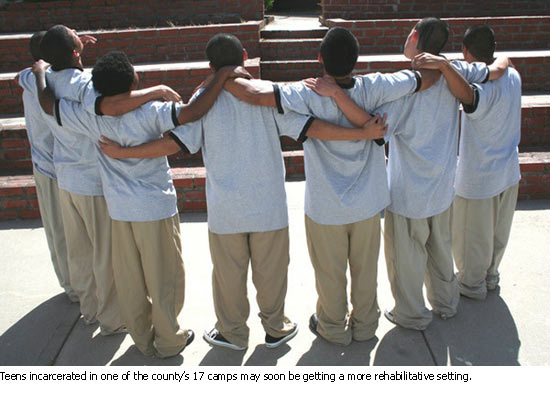 Helping a troubled adolescent isn’t easy. Even more difficult is helping a hundred of them in one room, at the same time. That, however, has been the challenge for the Los Angeles County Department of Probation, which houses some 1,300 young offenders in its juvenile detention camp system.
Helping a troubled adolescent isn’t easy. Even more difficult is helping a hundred of them in one room, at the same time. That, however, has been the challenge for the Los Angeles County Department of Probation, which houses some 1,300 young offenders in its juvenile detention camp system.
Research has shown that the most effective programs take place in small group settings. But the county’s 17 camps, many built decades ago, still feel more like military camps than places where a troubled kid might be rehabilitated—little room for study and introspection, but plenty of space for power struggles and gang fights.
On Tuesday, the Board of Supervisors took a first step toward giving Los Angeles County’s juveniles a more rehabilitative setting. Acting on a motion by Supervisors Zev Yaroslavsky and Don Knabe, the board voted to pursue a $28 million state grant to transform one the county’s 17 camps into a state-of-the-art rehabilitative compound.
“This is a modest attempt to change the dynamics in one camp and the outcomes in one camp, so hopefully we’ll learn a few things and begin to convert other aspects,” Yaroslavsky said. “We’ve got to do something about these camps.”
Although the supervisors are examining which camp to refurbish, the county’s grant application was clear on the goal—to create a more therapeutic model by replacing the old, military-like settings with smaller cottages and more intimate areas for dining and meeting.
“Right now, it’s like a teacher trying to teach a classroom with 50 kids rather than 20,” said the probation department’s chief deputy, Cal Remington. “We’re trying to get these kids to think positively about what we’re trying to teach them. But it’s hard for them to think about anything but each other and status in these big settings.”
Evidence, he said, has repeatedly shown that troubled adolescents are much more likely to change their behavior and attitude when they’re housed as small groups. “A lot of people like the idea of boot camp, but the evidence shows that they don’t change behavior. They just force some kids to say, ‘Yes sir’ and ‘No sir’.”
Jackie Caster, a Los Angeles youth advocate who, like many, has been pushing for some time for improvements to the county’s troubled and outdated juvenile detention program, said changing the layout of the detention camps is crucial.
A year and a half ago, Caster said, she and a number of county officials and academics visited Missouri, where the effectiveness of the juvenile justice system has been held up as an example nationwide. Although comparisons between the rural Midwest and urban Los Angeles are tricky, both she and Remington said that Missouri’s costs and recidivism rates appear to be much lower than L.A.’s.
The secret, Remington said, lies in calmer, more intimate settings that force the juveniles to engage with staff and peers one-on-one. In Missouri, he and others said, the teenagers are put into smaller group homes, given intensive individual and family therapy and academic instruction and taught teamwork and conflict resolution.
Rooms built for small group interaction allow for more counseling and better treatment. The Missouri camps, Caster said, “don’t look like institutions. They have carpets on the floor, pictures on the walls. The kids have bunks and closets. They’re made to feel valued, not just institutionalized.”
The grants are authorized by the state’s 2007 Juvenile Justice Reform Bill, which shifted California’s non-violent juvenile offenders into county programs and facilities. As part of that measure and subsequent legislation, the state authorized some $300 million in lease-revenue construction bonds for the design and construction of new or renovated county facilities for youthful offenders.
Los Angeles County’s proposal is not the largest to have been approved under the program. Alameda County is planning to build a similar 150-bed girls’ camp for $35 million. Still, several supervisors expressed concern that the grants might fall through, given the state’s financial problems. Also the program requires that the county ante up a $2.8 million cash match, plus a 15% contribution of in-kind services such as architectural planning.
Robert J. Takeshta, deputy director of the California Corrections Standards Authority, which administers the program, said that if the county sets the paperwork in motion, it could still decline the grant if the supervisors decided not to go through with the project. The money, he says, would simply go back into the pot to fund another juvenile justice project elsewhere in the state.
Said Supervisor Knabe: “Why leave money on the table when we have the ability to pull the plug if we want to?”
Posted 3/1/11
Tax tips from our consumer watchdogs
March 1, 2011

Tax refunds are among the few things to look forward to when it comes to W-2 season. And in this tough economy, taxpayers may be tempted by promises to speed up the gratification with so-called instant “refund anticipation” loans.
But the Los Angeles County Department of Consumer Affairs has a message for anyone who might be considering such an offer: Don’t.
“You don’t need to do it to get your money quickly,” says Acting Consumer Affairs Director Rigo Reyes. “And people typically end up paying very hefty fees they don’t need to pay.”
Such loans—usually billed by commercial tax preparers as “instant” or “rapid” refunds—typically offer consumers their refund money the moment their tax paperwork is finished. But Reyes says they are among the most common tax season consumer traps.
They’re actually short-term loans with massive interest rates—as high as 300 percent in some cases. They can not only substantially reduce a refund, but leave a taxpayer owing more money if it turns out that the preparer miscalculated the tax obligation. And with electronic filing, taxpayers don’t really need them.
“Yes, years ago, it did used to take a couple of months to get a refund,” says Reyes, “but today, you can ask for an electronic refund and get your money in less than two weeks.”
If you have questions about these loans, or have been taken advantage of and want to file a complaint, call the Department of Consumer Affairs at 800-593-8222 or click here.
By the way, that’s not all the advice the county’s consumer watchdogs have for taxpayers. Here, courtesy of Reyes’ team, are a few other tax-season tips (Spanish-speakers can click here, here and here):
Don’t buy into claims that you can get away without paying your taxes.
“Don’t believe someone who tells you that you don’t have to pay taxes because of some special law or constitutional loophole that only they know about,” Reyes says. The IRS has a list of frivolous anti-tax arguments that have already been tested in court and shot down. (“One year,” says Reyes, “it was a claim that if you were descended from slaves, you didn’t have to pay because the government owed you slave reparations.”) Taxpayers are free to contest their taxes in court, but tax evasion is a serious crime with serious penalties, says Reyes.
Don’t respond to unsolicited emails claiming to be from the IRS.
The IRS doesn’t request personal financial information via email. But phishers do, and then use it to commit identity theft. If you get a suspicious email purporting to be from the IRS, don’t reply, open any attachments or click on any links. Forward it as-is to [email protected] and, for more information, visit their identity protection page.
Vet your tax preparer.
Even if your best friends recommend a person, take the time to check him or her out. California law requires all tax preparers to register with the appropriate licensing agency. If your tax preparer is a lawyer, make sure he or she is legit at the State Bar of California. If you’re going with a certified public accountant, verify their license at the California Board of Accountancy. Any other kind of tax preparer must be bonded to protect clients against fraud and registered as an “enrolled agent” or a registered tax preparer (RTP) through the California Tax Education Council, where you can look up their status on this handy verification page. For enrolled agents, call the IRS office of Professional Responsibility at (313) 234-1280.
Consider doing it yourself this year.
If you don’t want to spend the money on a tax preparer, filing may not be as difficult as you remember. The state and federal government offer lots of free tax-preparation programs, and taxpayers can file their taxes online. The IRS’s Free File lets taxpayers file for free online and get a refund in 10 days. Low-income taxpayers can get free help through the IRS’s Volunteer Income Tax Assistance Program, which offers state and federal tax preparation help in several languages. To find a VITA site in Los Angeles County, call (800) 829-1040 or click here or here. There’s state and federal help for seniors, too, both through the IRS’s Tax Counseling for the Elderly Program and through the American Association of Retired People. For an IRS/Franchise Tax Board senior counseling site in Los Angeles County, call (800) 829-1040 or click here. For an AARP site, call (888) 227-7669 or click here.










 Check for the latest closure information
Check for the latest closure information








